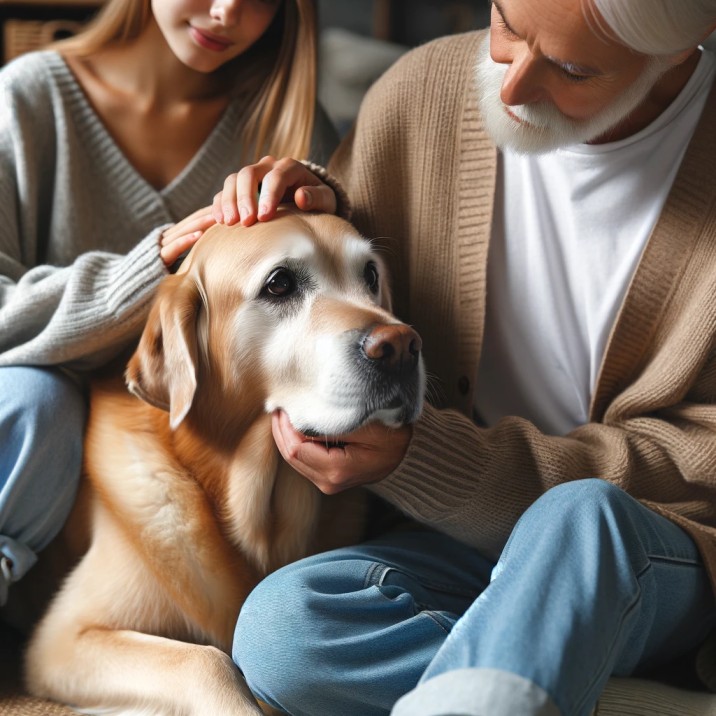Can dogs get depressed? Yes, dogs can experience depression, although it may not manifest in the same way as it does in humans. Understanding canine depression involves recognizing the signs, identifying potential causes, and knowing how to help your pet.
Signs of Depression in Dogs
Dogs can’t communicate their feelings in words, so it’s important to pay attention to changes in their behavior. Signs of depression in dogs can include:
- Loss of Interest: Dogs may lose interest in activities they once enjoyed, like playing, going for walks, or interacting with other pets and people.
- Changes in Appetite: Depressed dogs might eat less or show no interest in their food. In some cases, they might eat more.
- Sleep Changes: Just like humans, depressed dogs may sleep more than usual. A noticeable increase in the time spent sleeping or lying down can be a sign of depression.
- Lack of Energy: Dogs suffering from depression often show decreased energy levels and general lethargy.
- Hiding or Avoidance Behavior: Depressed dogs might hide or avoid interaction with their family members.
- Excessive Licking or Grooming: Some dogs may groom themselves excessively when they are stressed or depressed.
Causes of Depression in Dogs
Several factors can contribute to depression in dogs:
- Loss of a Companion: Dogs can mourn the loss of another pet or a human family member.
- Changes in Environment: Moving to a new home, changes in the household, or a new family member (including pets) can affect a dog’s emotional state.
- Health Problems: Chronic pain or debilitating illnesses can lead to depression.
- Lack of Social Interaction: Dogs are social animals, and prolonged isolation or lack of attention can lead to depressive symptoms.
- Changes in Routine: Dogs thrive on routine, and significant changes can be stressful.
Diagnosing Depression in Dogs

Diagnosing depression in dogs can be a challenging process, as it largely depends on the observation of behavioral changes rather than definitive medical tests. Unlike in humans, where verbal communication allows for a direct expression of feelings, understanding a dog’s emotional state requires careful observation of their behavior and lifestyle patterns.
The primary method of diagnosing depression in dogs is through the observation of changes in their behavior. Owners and veterinarians look for signs such as reduced interest in play, decreased social interaction, changes in eating and sleeping habits, and a general decline in activity levels. Sudden changes, like a normally energetic dog becoming lethargic or a friendly dog avoiding interaction, are red flags that might indicate depression.
A thorough medical evaluation is crucial in ruling out physical health issues that could cause symptoms resembling depression. Conditions such as hypothyroidism, chronic pain, and hormonal imbalances can manifest in ways similar to depression. A veterinarian will perform a comprehensive physical examination and may recommend blood tests, hormonal assays, and other diagnostic procedures to ensure there is no underlying medical condition. Understanding the context of a dog’s life is essential in diagnosing depression. Veterinarians and pet owners must consider recent life changes that could affect the dog’s emotional state. This includes events like the loss of a companion (animal or human), a move to a new home, changes in the family structure, or a change in the owner’s schedule.
It’s important to distinguish between true depression and conditions that might mimic depressive symptoms, such as chronic fatigue syndrome or cognitive dysfunction in older dogs. Behavioral changes associated with these conditions might be mistaken for depression. In some cases, veterinarians may collaborate with animal behaviorists or veterinary behavior specialists. These experts can offer deeper insights into a dog’s behavior and help distinguish between behavioral issues and depression.
Diagnosing depression in dogs is a process that combines medical evaluation, behavioral observation, and understanding the dog’s environmental and social context. It requires a collaborative effort between the dog owner and veterinary professionals to accurately identify and address this emotional disorder. Early recognition and intervention are key to effectively managing and treating depression in dogs, enabling them to lead happier and healthier lives.
Treatment and Management

Treatment for depression in dogs varies depending on its cause:
- Environmental Enrichment: Providing more social interaction, physical exercise, and mental stimulation can help. This includes regular walks, playtime, and training sessions.
- Establish Routine: Maintaining a consistent daily routine can provide a sense of security and normalcy.
- Behavioral Therapy: Working with a professional dog trainer or a veterinary behaviorist can be beneficial.
- Medical Treatment: In severe cases, veterinarians may prescribe medications similar to human antidepressants. However, this is typically considered only after other treatments have failed.
The Role of the Owner
The role of the dog owner is pivotal in both identifying and helping a dog through depression. As the primary caretaker and the one most familiar with the dog’s normal behavior and personality, the owner is often the first to notice any changes that might indicate depression.
Owners need to actively observe their dog’s behavior and take note of any significant changes. This includes monitoring their daily activities, interactions, eating and sleeping patterns, and general demeanor. Subtle changes, such as a decrease in enthusiasm for activities the dog once enjoyed or a lack of response to affection, can be early signs of depression.
Dogs are highly social animals and respond to emotional cues from their owners. Providing consistent affection, attention, and comfort can help alleviate feelings of loneliness or neglect that might contribute to depression. This might include more cuddle time, gentle petting, and engaging in activities that the dog finds comforting.
Adequate physical exercise and mental stimulation are crucial for a dog’s well-being. Owners should ensure regular walks, playtime, and engagement in activities that stimulate the dog’s mind and body. Introducing new toys, teaching new tricks, or even changing walking routes can provide the necessary stimulation. Dogs thrive on routine, and maintaining a consistent schedule for meals, walks, and bedtime can provide a sense of security and normalcy. This is especially important in times of change, such as after a move or the addition of a new family member. If signs of depression persist, the owner should consult a veterinarian or a professional animal behaviorist. They can provide guidance and, if necessary, recommend appropriate treatment or behavioral therapy.
The owner plays a critical role in a dog’s mental health. By providing emotional support, ensuring physical and mental engagement, maintaining routine, and seeking professional help when needed, owners can significantly impact their dog’s recovery from depression. The bond between a dog and its owner is a powerful tool in combating canine depression.
If you notice any signs of depression in your dog, it’s important to consult a veterinarian. They can rule out medical problems and guide the best course of action.
Depression in dogs is a real and serious condition. It requires attentive care and understanding from the owner. By recognizing the signs and seeking professional help, owners can play a vital role in helping their dogs recover. It’s important to remember that with proper care and attention, most dogs can overcome depression and lead happy, fulfilling lives.

